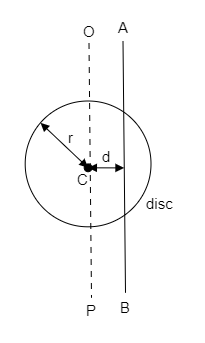Question
Question: The radius of gyration of a uniform disc about a line perpendicular to the disc equals its radius. F...
The radius of gyration of a uniform disc about a line perpendicular to the disc equals its radius. Find the distance of the line from the centre.
Solution
The given line is mentioned to be perpendicular to the disc. As the radius of gyration equals the radius of the disc, the required distance can be obtained using the parallel axis theorem. The parallel axis theorem gives the moment of inertia of the disc about the given line as the sum of the moment of inertia of the disc about an axis passing through its centre of mass and parallel to the given line and the product of its mass and the square of the required distance.
Formulas used:
-The moment of inertia of a disc about a perpendicular axis passing through its centre is given by, I=2mr2 where m is the mass of the disc and r is the radius of the disc.
-The moment of inertia of a body is given by, I=mk2 where m is the mass of the body and k is the radius of gyration of the body.
Complete step by step answer.
Step 1: Sketch a figure representing the given line perpendicular to the disc and list the parameters of the given disc.

In the above figure, C represents the centre of the disc. AB is the line perpendicular to the disc at a distance d from the centre. OP represents the axis passing through the centre of the disc and is perpendicular to the disc.
The radius of the disc is denoted by r .
Let k be the radius of gyration of the uniform disc. It is given that the radius of gyration about the axis AB equals the radius of the disc ie., k=r .
Let m be the mass of the disc.
The moment of inertia about the axis OP which is perpendicular to the disc and passing through the centre is known to be IOP=2mr2 -------- (1)
Step 2: Express the moment of inertia of the disc about the axis AB using the parallel axis theorem.
The moment of inertia of the disc about the axis AB is usually expressed in terms of the radius of gyration as IAB=mk2
Since k=r , we have IAB=mr2 --------- (2)
We can also express the moment of inertia about AB based on the parallel axis theorem as IAB=IOP+md2 ---------- (3)
Substituting equations (1) and (2) in (3) we get, mr2=2mr2+md2
⇒2mr2=md2
Cancelling m on both sides of the above expression and rearranging we get, d2=2r2
⇒d=2r
Thus the distance from the centre to the axis AB is d=2r .
Note: The radius of gyration is a geometric property of a body. It also depends on the position and configuration of the axis of rotation of the body. The centre of mass of the body is independent of the axis of rotation and it is fixed as the body rotates. However, the radius of gyration will change in response to the variations in the axis of rotation.
